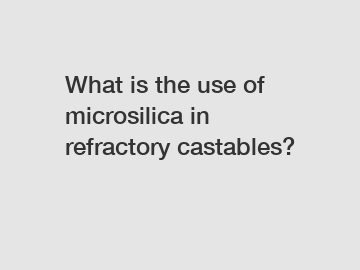What is the use of microsilica in refractory castables?
Refractory castables are vital materials used in various industrial applications such as steel-making, cement production, petrochemicals, and more. These materials play a crucial role in maintaining the integrity and functionality of high-temperature processes and equipment. One essential component that contributes significantly to the performance of refractory castables is microsilica.
Microsilica, also known as silica fume, is a byproduct of silicon and ferrosilicon metal production. It is a highly reactive form of silica that is typically produced during the smelting process and consists of ultrafine particles of amorphous silicon dioxide. Microsilica is added to refractory castables to improve their properties and enhance their performance in high-temperature environments.
One of the main advantages of using microsilica in refractory castables is its ability to reduce water demand. Microsilica has a high surface area and a strong pozzolanic reaction with calcium hydroxide, which helps in densifying the castable matrix. This results in a reduced porosity and improved strength, density, and abrasion resistance of the castable. Additionally, the reduced water demand allows for better workability and easier installation of the castable.

Microsilica also acts as a filler material in refractory castables, improving their thermal shock resistance. The fine particles of microsilica fill the voids between larger particles in the castable matrix, forming a dense and uniform structure. This helps in reducing thermal gradients within the castable, preventing cracks and spalling when exposed to sudden temperature changes. The improved thermal shock resistance of microsilica-enhanced castables makes them ideal for applications where the material is subjected to rapid heating and cooling cycles.
Furthermore, microsilica plays a crucial role in enhancing the refractory properties of castables. It provides a high degree of bond strength between the aggregate particles and the binder system, resulting in improved hot modulus of rupture (HMOR) and hot modulus of elasticity (HMOE) of the castable. This translates to better resistance to mechanical and thermal stresses, ensuring the longevity and performance of the refractory lining in high-temperature applications.
Suggested reading:Ultimate Guide to High Temp Castable Refractory
Is Microsilica 95 Grade the Ultimate Game-Changer?
Ultimate Guide to Low Price Microsilica 85
Unlock the Secrets of Silica Fume Concrete: A Comprehensive PPT Guide
Ewenda: Is This the New Superfood Craze?
1. Unleashing the Power of Raw Silica Fume: A Comparison2. 5 Ways Raw Silica Fume Can Transform Your Project3. The Mystery of Raw Silica Fume: What You Need to Know4. Expert Tips for Using Raw Silica
Key Questions to Ask When Ordering Densified Micro Silica Fume
In addition to its mechanical properties, microsilica also improves the corrosion resistance of refractory castables. The reactive silica particles react with alkalis and other corrosive elements present in the environment, forming stable compounds that protect the castable from chemical attack. This is especially beneficial in industries such as incineration, where the lining is exposed to aggressive gases and liquids that can degrade the refractory material over time.
Moreover, microsilica has a significant impact on the flow properties of refractory castables. Its ultrafine particles act as lubricants, reducing the friction between the aggregate particles and facilitating the flow of the castable during installation. This results in better compaction and reduced segregation of the castable, leading to an homogeneous and well-bonded lining that offers superior performance in high-temperature environments.
In conclusion, microsilica is a versatile and essential additive in refractory castables, offering a wide range of benefits that improve the performance and durability of the material. Its ability to reduce water demand, enhance thermal shock resistance, strengthen the bond between particles, increase corrosion resistance, and improve flow properties make it a valuable ingredient in high-temperature applications where refractory materials are subjected to extreme conditions.
When selecting a refractory castable for your specific application, consider the addition of microsilica to optimize the performance and longevity of the material. Its unique properties and benefits make it an indispensable component in the formulation of high-quality and high-performance refractory castables that can withstand the rigors of industrial operations and provide reliable protection for equipment and structures against the harsh conditions of high-temperature environments.
If you are looking for more details, kindly visit Silica Fume for Refractories, Densified Micro Silica Fume, China Micro Silica Fume Powder Factory.
Suggested reading:Crucial Differences Revealed in 92% Undensified Silica Fume Archives
What Are the Advantages of Silica Fume for Refractories?
The 5 most common ways to use HPMC
Embrace HPMC for Self-Leveling Wonders
The Difference Between Whole-Body and Full-Body Cryotherapy
Liquid Silicone Injection Molding for Medical Products from ...
When to Use high quality 1,3-dimethylurea?









